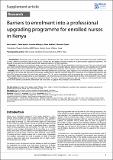| dc.contributor.author | Lakati, Alice | |
| dc.contributor.author | Ngatia, Peter | |
| dc.contributor.author | Mbindyo, Caroline | |
| dc.contributor.author | Mukami, Diana | |
| dc.contributor.author | Oywer, Elizabeth | |
| dc.date.accessioned | 2021-08-16T23:35:26Z | |
| dc.date.available | 2021-08-16T23:35:26Z | |
| dc.date.issued | 12/25/2012 | |
| dc.identifier.citation | Alice Lakati, Peter Ngatia, Caroline Mbindyo, Diana Mukami, Elizabeth Oywer. Barriers to enrolment into a professional upgrading programme for enrolled nurses in Kenya. Pan Afr Med J. 2012;13(Supp 1):10 | en_US |
| dc.identifier.issn | 1937-8688 | |
| dc.identifier.uri | http://dspace.amref.org/handle/123456789/61 | |
| dc.description | This article is published as part of the supplement “AMREF´s evidence in advancing the health of women and children”
Supplement sponsored by AMREF - African Medical and Research Foundation
© Alice Lakati et al. The Pan African Medical Journal - ISSN 1937-8688. This is an Open Access article distributed under the terms of the Creative Commons Attribution License (http://creativecommons.org/licenses/by/2.0), which permits unrestricted use, distribution, and reproduction in any medium, provided the original work is
properly cited. | en_US |
| dc.description.abstract | Introduction: Nurses play a key role in the provision of health care. Over 70% of the nurses in Kenya are Enrolled Community Health Nurses
(ECHNs). AMREF in partnership with Nursing Council of Kenya and the Ministry of Health pioneered an eLearning Nurse Upgrading Programme. The
purpose of this study was to identify barriers that hindered enrolment into the programme.
Methods: A descriptive cross-sectional design was used. A sample of 532 ECHNs was interviewed from four provinces. Data was collected using
a pre-tested self administered questionnaire. Analysis was done using SPSS computer software. Descriptive statistics were calculated for all variables
and chi-square tests used to determine variables that were associated with enrolment. Mann Whitney U-test was used for continuous variables.
Results: A third (29.7%) of the nurses were from Rift Valley province and 17.9% from Coast. Majority (75%) were from public health facilities. The
mean age of the nurses was 40.6 years. The average monthly income was KES 22,497.68 (USD 294). Awareness of the upgrading programme was
high (97%) among the nurses. The cost of fees was the main (74.1%) barrier to enrolment in all the provinces and across all the health facilities. The
type of health facility was significantly (p<0.05) associated with enrolment. Nurses from faith-based health facilities were less likely to have enrolled.
Conclusion: Awareness of the upgrading programme is high. The cost of upgrading programme, age and working in a faith-based health facility
are the main barriers to enrolment. Intervention that fund nurses to upgrade would increase nurse enrolment. | en_US |
| dc.description.sponsorship | Programme partner institutions - the Ministries of Medical Services and
Public Health (MoMs and MoPHs), Nursing Council of Kenya (NCK), Kenya
Medical Training Colleges (KMTC), Christian Health Association of Kenya
(CHAK), the Kenya Catholic Secretariat (KCS) | en_US |
| dc.publisher | Pan African Medical Journal | en_US |
| dc.subject | Enrolment, barriers | |
| dc.subject | Enrolment | |
| dc.subject | Training program | |
| dc.subject | Curriculum | |
| dc.subject | Nurses | en_US |
| dc.title | Barriers to Enrolment into a Professional Upgrading Programme for Enrolled Nurses in Kenya | en_US |
| dc.type | Article, Journal | en_US |

